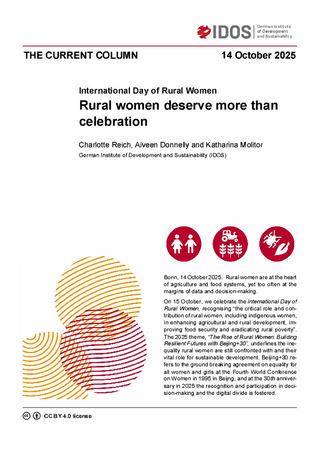International Day of Rural Women
Rural women deserve more than celebration
Reich, Charlotte / Aiveen Donnelly / Katharina MolitorThe Current Column (2025)
Bonn: German Institute of Development and Sustainability (IDOS), The Current Column of 14 October 2025
Bonn, 14 October 2025. Rural women are at the heart of agriculture and food systems, yet too often at the margins of data and decision-making.
On 15 October, we celebrate the International Day of Rural Women, recognising “the critical role and contribution of rural women, including indigenous women, in enhancing agricultural and rural development, improving food security and eradicating rural poverty”. The 2025 theme, “The Rise of Rural Women: Building Resilient Futures with Beijing+30”, underlines the inequality rural women are still confronted with and their vital role for sustainable development.
Facts abound on women’s critical role in agricultural production, fulfilling essential tasks such as planting, harvesting and processing crops; in managing household food and nutrition security and in being stewards of natural resources for future generations. However, women are also often among the poorest in rural areas and make up the bulk of the world’s illiterate population. Estimations are unrelenting regarding women’s potential if only they would have the same access and opportunities as men, or if only the gender pay gap would be closed, millions of people would be lifted out of poverty.
One thing is clear: Rural women are multipliers in their communities, with investments in them shown to generate broad gains in nutrition, education and health. Yet to realise this, policies must be grounded in a nuanced understanding of rural women’s diverse realities. Behind the celebration of “rural women” lies a persistent simplification: who, in fact, is the rural woman? Data gaps exist, reflecting the diversity of women.
Recognising these limitations has prompted efforts to strengthen gender-disaggregated data systems. The World Bank’s Gender Disaggregated Labour Database provides detailed insights into women’s participation in different occupational categories. The UN Women Data Hub compiles data to support monitoring of the Sustainable Development Goals from a gender perspective. Similarly, the Women’s Empowerment in Agriculture Index (WEAI) measures women’s agency and inclusion in agricultural decision-making on individual-level data. Yet, even as data availability improves, existing evidence highlights the persistence of gender inequalities and signals the limits of what is currently known.
Thus, despite progress, our current data systems often fail to capture the diversity of women’s realities. What we know is that women continue to face discrimination vis-a-vis men, and we are aware of the intersectionality of discrimination. This manifests in unequal access to, control over and ownership of essential resources. In asymmetric power relations and exclusion from decision-making processes, as well as in gendered divisions of labour, gender-based violence and social norms unfavourable to women’s empowerment. While discrimination against women is well documented, the intersectional realities remain insufficiently captured. Yet the intersection of gender with age, ethnicity, marital status, class, and geography creates distinct configurations of access and exclusion. Here, cracks in the data begin to show.
In many cases, our assumptions about women – what we think we know – obscure underlying biases in how data is collected and interpreted. Most data are collected on household level and from public resources, typically taking the male point of view. For example, the household might hold the land title, but this does not mean that women have decision-making power when it comes to how the land is used. Mechanised farming equipment might be purchased by the household income; however, this does not mean to say that a woman has the capability to use the equipment due to lack of training for example.
Finally, there are dimensions that characterise women independently that remain entirely outside our current knowledge. Thus, to give sound policy advice on how to support rural women and fully recognise their critical role, we need to increase our awareness of what we do not yet know. Including a gender variable in a survey is no longer sufficient. True inclusivity requires transformative approaches to research design and methodology. Participatory methods — such as community learning platforms, focus group discussions, and co-created research processes — can be a good way to uncover sensitivities within households and communities.
Ultimately, on this International Day of Rural Women development partners, governments, researchers and communities should commit to highlighting rural women as the diverse and indispensable actors they are and to increase our awareness of what we do not know. Seeing rural women in all their diversity and addressing persistent gaps in resources, rights and data are actionable steps towards gender equality, healthier environments and more inclusive rural economies.



